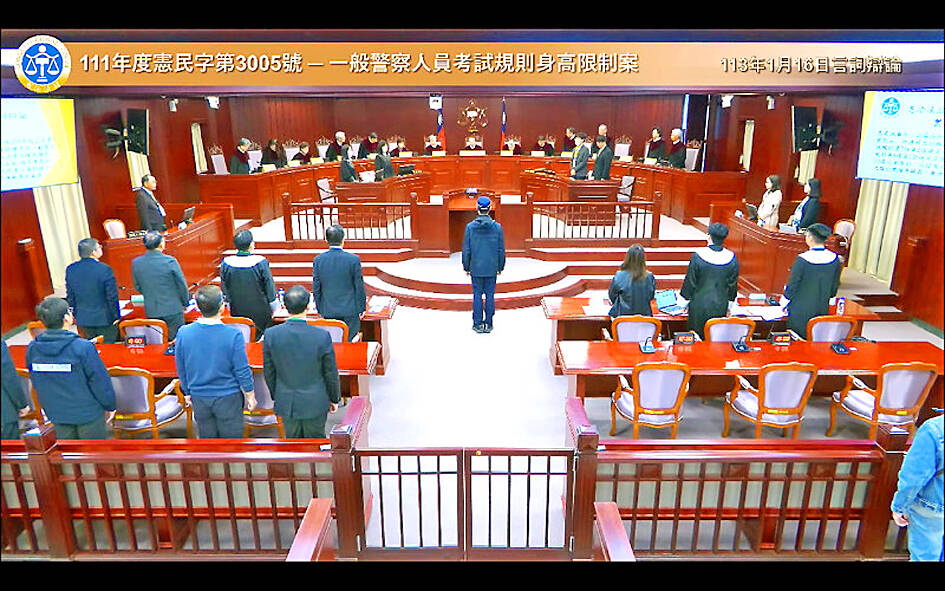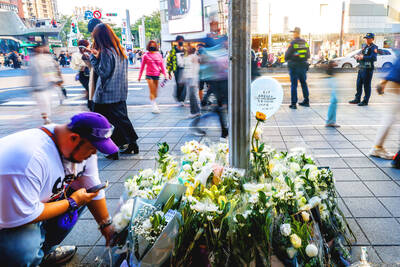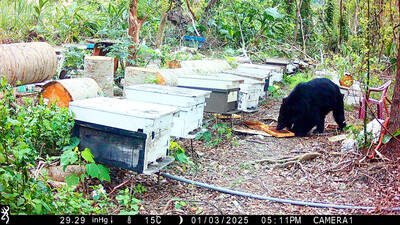The Constitutional Court on Tuesday heard oral arguments in the case of a woman suing the government for discrimination after being disqualified from serving as a firefighter because she was deemed too short.
In 2018, the plaintiff, surnamed Chen (陳), passed the class 4 firefighter and police certification test, but failed the physical examination as, at 158.9cm, she was 1.1cm short of the height requirement.
The Civil Service Protection and Training Commission a year later rejected her application to be a firefighter, citing the height requirement stipulated in the regulations governing qualifications for police officers and firefighters.

Photo: Screen grab from a Constitutional Court’s video
Chen’s lawyer told the court that the height requirement is discriminatory and that barring Chen from becoming a firefighter is an infringement of her right to work in government.
The requirements that non-
indigenous female police and firefighter applicants must be at least 160cm tall has no rational basis, her lawyer said, adding that setting separate certification standards for genders and ethnicities is discriminatory.
The height requirement for men to join the service is less stringent than for women, as more than 90 percent of 18-year-old Taiwanese men meet the 165cm requirement, but only 45 percent of 18-year-old Taiwanese women meet the 160cm requirement, the lawyer said.
Setting height requirements according to gender and ethnicity is a form of discrimination based on intrinsic and unalterable traits, which is not constitutionally justifiable, the lawyer said.
In addition, the regulation states that physical examinations are to be conducted “when necessary,” which is vague legal language that contravenes the doctrine against ambiguity in law, they said.
Lawyers representing the Ministry of Examination and the Ministry of the Interior said that the rules on height requirements are to help ensure that firefighters and police officers are strong enough to perform their functions, which is legally justifiable.
The opportunity to work in public service is rightfully limited to people possessing appropriate competencies and qualifications, they said.
Establishing standards for a type of service is typically the executive branch’s prerogative, which cannot be challenged without cause, the lawyers said.
Height standards differ according to gender due to fieldwork requirements, they said, adding that the height requirement for indigenous people, who are shorter than the average Taiwanese, is lower to ensure equal opportunities.
The recruiting agency’s order for Chen to undergo additional physical examinations to ensure she met the physical standards is a proper exercise of discretion and demonstration of what necessity meant in the rules, they said.
Removing the height requirement would compromise public safety and could place the lives of first responders at a higher risk, National Fire Agency Director-General Hsiao Huan-chang (蕭煥章) told the court.
Judicial Yuan President Hsu Tzong-li (宗力諭) said the court would deliver its judgement no later than five months after the hearing in accordance with the law.

SHIPS, TRAINS AND AUTOMOBILES: The ministry has announced changes to varied transportation industries taking effect soon, with a number of effects for passengers Beginning next month, the post office is canceling signature upon delivery and written inquiry services for international registered small packets in accordance with the new policy of the Universal Postal Union, the Ministry of Transportation and Communications said yesterday. The new policy does not apply to packets that are to be delivered to China, the ministry said. Senders of international registered small packets would receive a NT$10 rebate on postage if the packets are sent from Jan. 1 to March 31, it added. The ministry said that three other policies are also scheduled to take effect next month. International cruise ship operators

HORROR STORIES: One victim recounted not realizing they had been stabbed and seeing people bleeding, while another recalled breaking down in tears after fleeing A man on Friday died after he tried to fight the knife-wielding suspect who went on a stabbing spree near two of Taipei’s busiest metro stations, Taipei Mayor Chiang Wan-an (蔣萬安) said. The 57-year-old man, identified by his family name, Yu (余), encountered the suspect at Exit M7 of Taipei Main Station and immediately tried to stop him, but was fatally wounded and later died, Chiang said, calling the incident “heartbreaking.” Yu’s family would receive at least NT$5 million (US$158,584) in compensation through the Taipei Rapid Transit Corp’s (TRTC) insurance coverage, he said after convening an emergency security response meeting yesterday morning. National

PLANNED: The suspect visited the crime scene before the killings, seeking information on how to access the roof, and had extensively researched a 2014 stabbing incident The suspect in a stabbing attack that killed three people and injured 11 in Taipei on Friday had planned the assault and set fires at other locations earlier in the day, law enforcement officials said yesterday. National Police Agency (NPA) Director-General Chang Jung-hsin (張榮興) said the suspect, a 27-year-old man named Chang Wen (張文), began the attacks at 3:40pm, first setting off smoke bombs on a road, damaging cars and motorbikes. Earlier, Chang Wen set fire to a rental room where he was staying on Gongyuan Road in Zhongzheng District (中正), Chang Jung-hsin said. The suspect later threw smoke grenades near two exits

The Forestry and Nature Conservation Agency yesterday launched a gift box to market honey “certified by a Formosan black bear” in appreciation of a beekeeper’s amicable interaction with a honey-thieving bear. Beekeeper Chih Ming-chen (池明鎮) in January inspected his bee farm in Hualien County’s Jhuosi Township (卓溪) and found that more than 20 beehives had been destroyed and many hives were eaten, with bear droppings and paw prints near the destroyed hives, the agency said. Chih returned to the farm to move the remaining beehives away that evening when he encountered a Formosan black bear only 20m away, the agency said. The bear